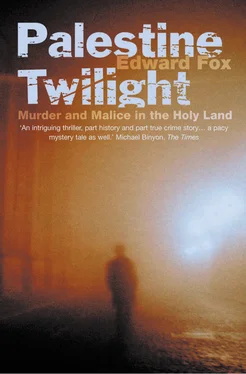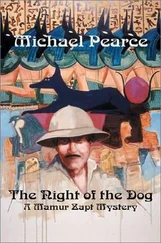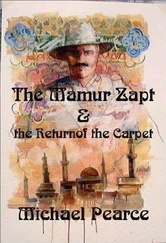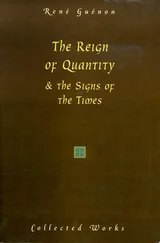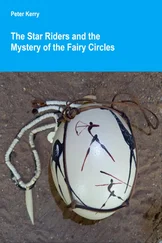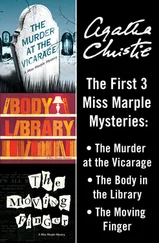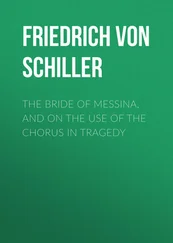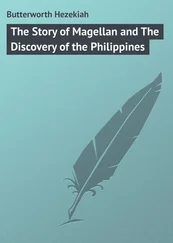By now it was between eleven o’clock and noon. Glock drove out of Ramallah and down into a valley where a bypass to an Israeli settlement crossed the road to Bir Zeit. Here there was usually an Israeli checkpoint, with a jeep, a strip of spiked chain across the road, and some surly young soldiers with machine guns slung over their shoulders stopping vehicles and checking identity cards. Glock was slyly proud of his skill at talking his way past these obstacles. Palestinian friends would marvel at how he managed to appear at their door on days when the tightest closures were in place, when no one was able to travel anywhere. He took full advantage of his appearance as a serious-looking, elderly foreigner. He was even careful to establish discreet but cordial relations with the few Israeli soldiers he saw more than once at the checkpoints, chatting with them, aware of their boredom. If this made it easier to go about his business he was willing to do it, though he was careful not to seem too friendly with the soldiers when he had a Palestinian passenger sitting beside him.
Covering the distance from Ramallah to Bir Zeit took about fifteen minutes. The road winds around rocky, rubbly hills, and through a few villages. Just outside Bir Zeit, he drove past the new campus, built in 1980, and now closed by military order, a limestone quarry at the side of the road, and the houses on the outskirts of the town, including the al-Farabi house. He knew that Maya had a dentist’s appointment in Ramallah that day, and he assumed that she would be back home by the time he finished work at the Institute. He drove through the compact town, whose position on a ridge gave it a grand view of the valley below, with tiers of crumbling olive terraces, some in use, some not, descending to a narrow plain where, according to local legend, the Roman general Titus encamped with his army in the year 70 before marching on Jerusalem to besiege it. From this road you could look down into the valley and across towards Ramallah, at the blinking lights of the radio masts, and on the top of a distant ridge, the Israeli settlement of Beit El, site of the region’s military headquarters, built on the traditional site of the biblical Bethel. On the slope below it one could see the Palestinian refugee camp of Jalazun. At night, these two enemy settlements, irreconcilable worlds of victor and vanquished, were visible only as streaks of light, the upper one brilliant white, the lower one yellow. When a power cut cast Bir Zeit and the surrounding area into darkness, Jalazun would seem to disappear, while Beit El, with its own source of power, blazed on.
This winter had been the coldest anyone could remember. There had been heavy snow, which stayed frozen on the ground for days. The snow brought down telephone lines and power cables, cutting off electricity and telephones, and the ice caused water pipes to burst. The people of Bir Zeit had endured long, bleak spells without electricity, telephone and water. In the narrow, layered terraces of rocky soil sculpted into the slopes, the cold froze and killed thousands of olive trees.
The olive tree is the emblem of Birzeit University, which is the main university in the Occupied Territories of Palestine. It is a good symbol for an institution that prides itself on being the hearth of Palestinian nationalism. The olive tree embodies the virtues that Palestinians like to see in themselves: it is ancient, it is tough, it is native, and it has deep roots. The name Bir Zeit means reservoir of oil. In the academic calendar of Birzeit University, a day is added to a weekend in the middle of October, and this three-day break is observed as Olive-picking Holiday. The idea is that, on this weekend, students return to their homes to help with the olive harvest. In reality, the Olive-picking Holiday is a political and nostalgic gesture rather than a matter of agricultural necessity. Few Palestinians any more have olive groves big enough to produce an economically viable crop.
In January 1992, Albert Glock was sixty-seven years old, and in his slow, perfectionist way was getting ready for retirement. He and Lois had been expatriates for so long, and were so deeply immersed in life among the Palestinians, that Glock felt he could never live in the United States again. For many years they had lived in a large, comfortable rented house in Bayt Hanina on the main Jerusalem road, with big airy rooms and a study full of the books and artefacts that Albert had accumulated over the years: everything they had was there, materially and spiritually. Now, on the verge of retirement, they were preparing to move to a smaller house in the same neighbourhood. The American way of life, a condition of comfortable ignorance of the rest of the world, as he saw it, had become foreign to Albert Glock. He called it ‘living in the bubble’. He had been visiting Cyprus now and then on the three-monthly trips out of the country he was compelled to make to renew his Israeli visa, and favoured settling there, but he had done nothing about it. This academic year he had relinquished most of his teaching responsibilities so that he could concentrate on completing the long-delayed publication of his life’s work, the excavation of an archaeologically complex site in the northern West Bank called Ti’innik.
The Institute of Archaeology was accommodated in an old-fashioned family house with two storeys, built around a central courtyard that was entered by an ornamental iron gate. It stood on the edge of Bir Zeit’s old town, a tight maze of dilapidated Ottoman buildings. To the right of the Institute, a car mechanic worked out of a dark cave of a workshop that had formerly been a blacksmith’s shop. Down a narrow lane, among the tiny houses, there was a bakery where traditional flat bread was baked in a dome-shaped oven, and a small Greek Orthodox church in a poor state of repair.
Glock worked alone that day. The shelves in his workroom were filled from floor to ceiling with the cardboard boxes, neatly marked, that contained the excavation material from his digs at Ti’innik and Jenin. The work tables in the room were covered with hundreds of blackened shards of burnt pottery, arranged in a state somewhere between order and chaos. The fragments were from Ti’innik, and Glock was working with Maya and a staff technician on the painstaking business of putting as many of the fragments as possible back together into their original forms as domestic pottery vessels. The pots bore a mysterious pattern of ridges that they could not identify. Several vessels had already been reassembled, among them a big two-handled water jar that dominated the room.
Ti’innik is a hamlet in the northernmost part of the West Bank, a few kilometres north of the town of Jenin in the flat, green Jezreel valley, near the biblical site of Megiddo, better known as Armageddon, where the Book of Revelation prophesies that the battle to end all earthly battles will be fought. The village stands at the foot of an ancient man-made mound called Tell Ti’innik, which is almost certainly the site mentioned in the Bible as the Canaanite stronghold of Taanach. In 1987, Glock and Maya al-Farabi took the radical step of excavating, not the parts of the site that relate to biblical history, which had been the dominant interest of the archaeology of Palestine since archaeology began in the Holy Land in the middle of the nineteenth century, but the more recent Ottoman remains which had been largely ignored by archaeologists.
Some time before three o’clock, he closed up the office and turned the key in the VW. He aimed to stop off briefly at the al-Farabi house to leave the message for Maya about her meeting. He would not stay long: his appointment with Gabi Baramki was more important. Before he left, he scribbled a note to Maya on the copy of the Arabic newspaper he had bought in Bayt Hanina, that day’s edition of al-Ittihad . He wrote across the top in block capitals, ‘I may be late tomorrow. Al,’ and left it where she would see it.
Читать дальше
